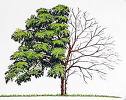Common Honey locust Tree Information
Images of Common Honey locust:






Common Honey locust grows in the following 33 states and provinces:
Alabama, Arkansas, Connecticut, Delaware, Florida, Georgia, Illinois, Indiana, Iowa, Kansas, Kentucky, Louisiana, Maryland, Michigan, Minnesota, Mississippi, Missouri, Nebraska, New York, North Carolina, Nova Scotia, Ohio, Oklahoma, Ontario, Pennsylvania, Rhode Island, South Carolina, South Dakota, Tennessee, Texas, Virginia, West Virginia, WisconsinInformation about Common Honey locust:
The Gleditsia Triacanthos is commonly known as the Common Honey-locust, Honey Shucks Locust, Honey-locust as well as Sweet Bean Locust.
The currently accepted scientific name for honey-locust is Gleditsia triacanthos L. (Cesalpiniaceae) . Thornless honey-locust (G. t. forma inermis Schneid.) is occasionally found wild . Natural hybridization between honey-locust and water-locust (G. aquatica) has been reported .The natural range of honey-locust extends from central Pennsylvania through extreme southern Ontario, extreme southern Michigan, southern Wisconsin, and extreme southeastern Minnesota to extreme southeastern South Dakota; south through eastern Nebraska to eastern Texas; east to Alabama; and northeast along the western slopes of the Appalachians. Isolated populations occur in northwestern Florida. Honey-locust is naturalized east of the Appalachians as far north as Nova Scotia .Honey-locust is usually only a minor component of natural forest stands. It is considered an accessory species in four SAF cover types: bur oak (Quercus macrocarpa), willow oak (Q. phellos)-water oak (Q. nigra)-diamondleaf (laurel) oak (Q. laurifolia), sweetgum (Liquidambar styraciflua)-willow oak, and sugarberry (Celtis laevigata)-American elm (Ulmus americana). Honey-locust is a secondary species in all other SAF cover types listed above . Mesophytic species commonly associated with honey-locust include red maple (Acer rubrum), persimmon (Diospyros virginiana), black tupelo (Nyssa sylvatica), sweet pecan (Carya illinoensis), boxelder (Acer negundo), Kentucky coffeetree (Gymnocladus dioica), and black walnut (Juglans nigra) .Some of the information provided here is attributed to:Sullivan, Janet. 1994. Gleditsia triacanthos. In: Fire Effects Information System, [Online]. U.S. Department of Agriculture, Forest Service, Rocky Mountain Research Station, Fire Sciences Laboratory (Producer). , available at the USDA Fire Effects Information System (FEIS) website